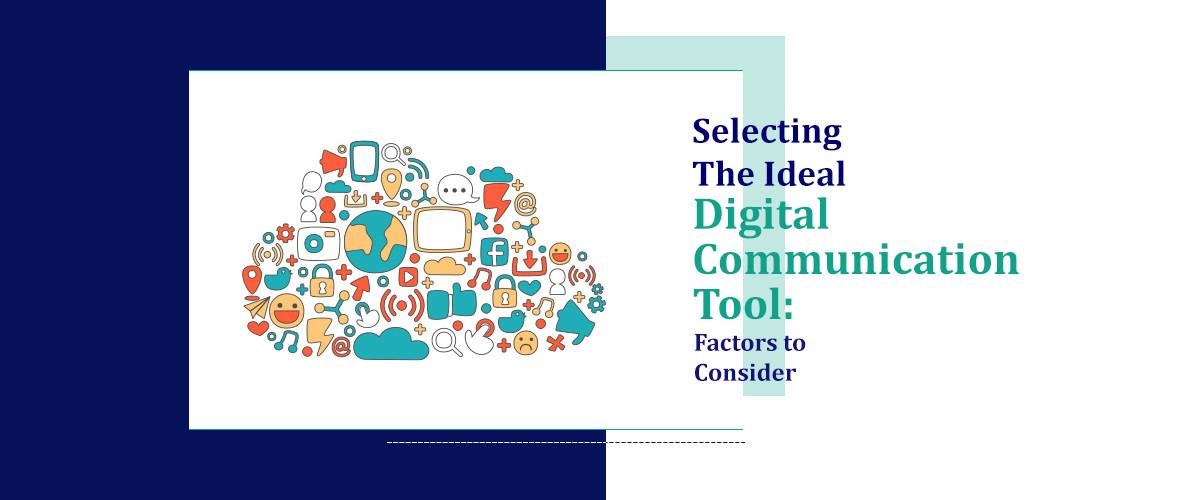What we'll cover
Snail mail. Telegraph. Pagers. These were some ways by which people communicated before digital technologies took over our lives.
Nowadays, we have plenty of options to get in touch, defying geographical boundaries. It’s easier than ever to stay connected. Among others, this is possible because of digital communication tools. It allows businesses to communicate with their clients, customers, and employees in real-time. Even for individual users, such platforms are changing the way people connect.
However, while virtual solutions are available, they’re not all the same. It’s vital to spend time comparing one to the other to make the right choice. In this article, we’ll look at the most important considerations, helping you choose the right digital communication tool.
Different Options for Different Needs
As a starting point, businesses must assess their needs. Next, they should identify their goals. With these two things in mind, they can choose the right tool to meet their requirements. Email leads the pack. From formal business communication to marketing outreach, email platforms are indispensable for today’s businesses. If there’s one problem, however, it’s that the response time can be slow. Plus, it can also result in information overload.
Instant messaging and chat platforms are also popular. For personal users, platforms similar to Omegle can provide a way to connect and build relationships, even with strangers. Meanwhile, for businesses, tools like Microsoft Teams and Slack can facilitate dynamic communication in a fast-paced environment.
Another option for a digital communication tool is a collaboration platform, such as Trello and Asana. They’re vital for project management, providing a streamlined way to assign tasks set deadlines, and track progress. Video conferencing tools are also must-haves. They’re valuable for remote and hybrid organizations, providing a way to communicate despite the distance. However, they can be bandwidth-intensive.
Businesses can also implement informal communication channels, mostly for entertainment and promoting work-life balance. Such platforms can allow employees to have more relaxed conversations. It can also have games, which employees can enjoy during their break time. Nonetheless, these tools must not disrupt users from their jobs and must encourage responsible use.
Important Factors to Consider When Evaluating Digital Communication Tools
As you narrow down your choices, different factors come into play.
-
Usability
An intuitive interface is a must-have. Meaning, it needs a clean layout and user-friendly buttons, making it a breeze to navigate. Using the digital communication tool must not require technical knowledge or extensive training.
Mobile access is also important. We’re living in a mobile-first world, so the functionalities must be accessible on the go. This means that the features on the desktop version must also be available when you use a smartphone or tablet.
-
Functionalities
Digital communication is a broad term. It goes beyond having two people communicate. Hence, online platforms must also offer different functionalities. Among others, one of the most important is file sharing. This makes it easier to share files of different sizes and types, quicker than email transmission.
It will also be good if the platform allows screen sharing. This way, you can troubleshoot problems or demonstrate processes easily. The person on the other end can see what’s exactly on your screen.
To be more functional, some platforms also have built-in automation capabilities. To be more functional, some platforms also have built-in automation tool capabilities. For example, an app can automatically integrate appointments into a calendar, so you won't miss important dates, such as meetings.
-
Reliability
Isn't it frustrating when systems are always down? This can impact business operations, negatively affecting reputation and customer satisfaction. Read reviews and learn from the experiences of other people. Look at the uptime guarantee, which is often expressed as a percentage. This gives an idea of how often disruptions can happen.
To be reliable, make an app for digital communication and must offer superior customer support. Whether it is through live chat, telephone, or email, it must be easy to connect to someone who can extend a helping hand. Assistance must be immediately available to resolve any issue, especially those that can hamper business operations.
-
Scalability
Business growth is one thing you probably want. However, you’ll need to start small. This also means that your needs can change over time. For instance, you might only have ten employees today. But what happens when your workforce becomes larger? Your chosen digital communication tool must offer scalability. If your communication system is VoIP, it should support Session Initiation Protocol to efficiently manage increasing communication demands as your business expands.
It must be easy to scale up or down depending on your organizational requirements. The plans must be flexible enough to meet your budget and needs.
Security Considerations
Online technologies bring tons of business benefits. At the same time, they also carry inherent risks. Among others, one of the most serious is a security breach. This can manifest in many ways. Among others, one potential threat is a data breach. This happens when the network lacks a secure infrastructure. Users might be transmitting information and files across a vulnerable network.
Account hijacking can also happen, which is when cybercriminals access accounts using social engineering or stolen accounts. This will let the perpetrator impersonate other people.
Malware and ransomware also pose serious threats. They can spread like wildfire and wreak havoc that can have serious consequences beyond just the financial aspect.
More than just choosing the right tool, users must be proactive to emphasize security. Below are the best things to do:
- Use secure passwords that are hard to guess. They must contain a combination of letters, numbers, and characters. A password manager is valuable.
- Use only trusted third-party apps from reputable developers. Read reviews from other users to confirm if the app is legitimate.
- Implement Multi-Factor Authentication to level up online security. This practice goes beyond simple reliance on passwords.
- Train users or employees. They must be familiar with the impact of cybersecurity threats, and more importantly, how to combat them.
When choosing a communication solution, prioritize security considerations to protect sensitive data and ensure compliance with regulations.
The Financial Aspect
Digital communication tools are investments for many businesses. Sure, you can find some for free, but in many cases, you need to pay a fee. The amount can be higher for larger entities. However, organizations must consider such as a necessary expense given the multitude of benefits it can bring.
Different pricing models are available. For example, it can come with a perpetual license, which means that you need to settle a one-time fee. In turn, you can use the service for a lifetime. Meanwhile, others are available as subscriptions. You’ll pay monthly, quarterly, or annually. In addition, the fees can be per user or a flat rate regardless of the number of users.
For paid platforms, having a free trial program is beneficial. This will allow users to try the app for a certain period. Doing so will let you determine its strengths and weaknesses. After this, you can decide if it suits your needs or if you should look for other choices. Other cost factors are also worth looking at. For instance, you might need to pay for training, making sure all employees are familiar with how the tool works. Maintenance and upgrades can also cost your business money.
It’s additionally essential to keep in mind different hidden or supplementary expenses related to virtual verbal exchange tools. For instance, education might be vital to ensure that personnel are completely cushty and talented in using the new platform. Many gear include a gaining knowledge of curve, especially those supplying advanced capabilities including integrated challenge management, AI-powered automation, or big customization options. Companies may need to put money into outside schooling applications or commit inner resources to upskill their groups.
Without right education, employees may not use the device to its complete potential, that can negate a number of the benefits of investing in a virtual communique platform in the first area. Another capacity cost is preservation and enhancements. While subscription-primarily based offerings typically include ordinary updates and protection as part of the package deal, companies using gear with a perpetual license might need to pay for important updates, technical assist, or troubleshooting services. These extra prices ought to be factored into the entire fee of possession over the years.
Downtime because of system protection or malfunctions can also result in productiveness losses that can indirectly boom operational costs. Customization can also add to the overall fee. Many organizations require specialised features or integrations with other structures, which includes CRMs or ERPs, to maximize the tool’s effectiveness. Vendors might also rate extra for those customizations, and ongoing assist might be had to make certain the tool keeps to characteristic as favored. Additionally, because the enterprise grows or its communication needs evolve, similarly customizations might be important, contributing to ongoing costs.
Finally, corporations should do not forget the price of switching gear if the chosen platform doesn’t workout ultimately. Migrating statistics, retraining personnel, and transitioning workflows may be each time-consuming and luxurious. Therefore, carrying out thorough studies and making use of trial durations becomes all of the more crucial to keep away from those capacity charges down the line.
Wrapping Up
Without a doubt, digital tools are changing the way we communicate. Therefore, it’s an indispensable tool in today’s businesses. There are many options available, but they do not offer the same things. From the built-in features to security protocols, they differ in many ways. Organizations must be proactive in comparing the alternatives, going beyond financial considerations.
Consider your team's needs, ease of use, security features, integration capabilities, and scalability.
Assess your team's communication preferences, workflow, and specific requirements before making a decision.
Avoid selecting tools with unnecessary features, overlooking compatibility issues, ignoring user feedback, and neglecting security concerns.
Yes, prioritize tools that offer seamless integration with your existing software stack to streamline workflows and enhance productivity.
Choose tools with robust encryption, access controls, and compliance certifications to safeguard sensitive information and ensure data privacy.



